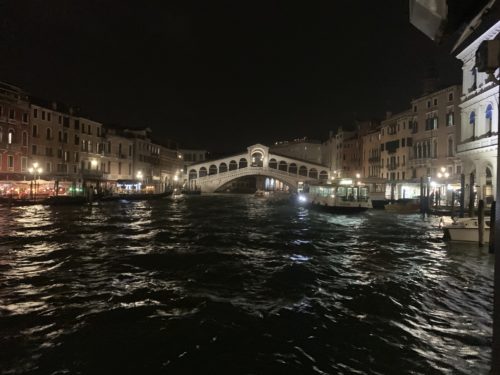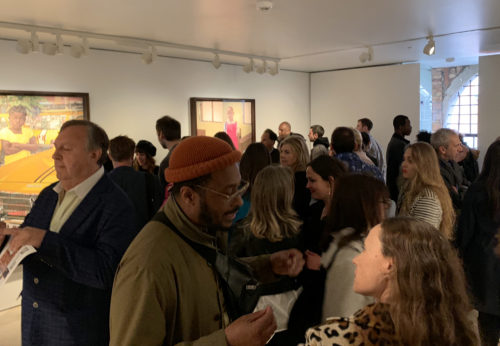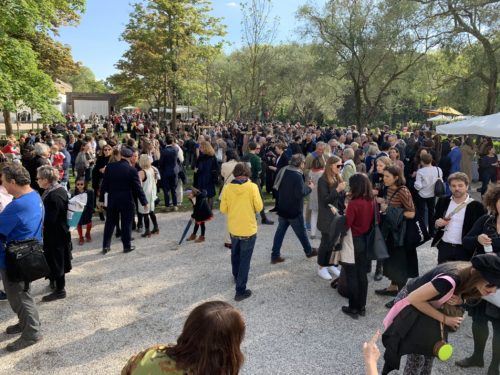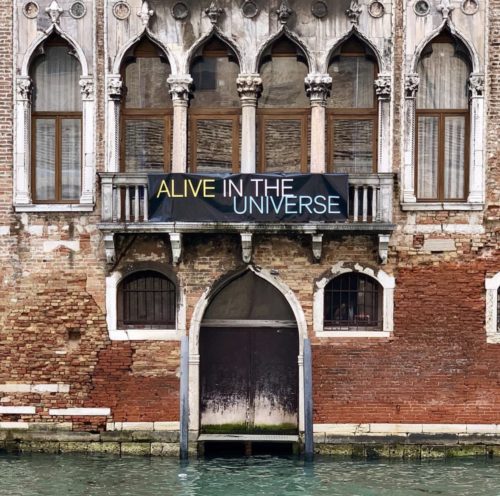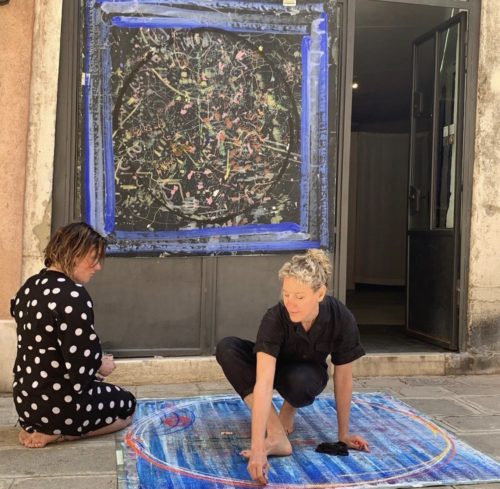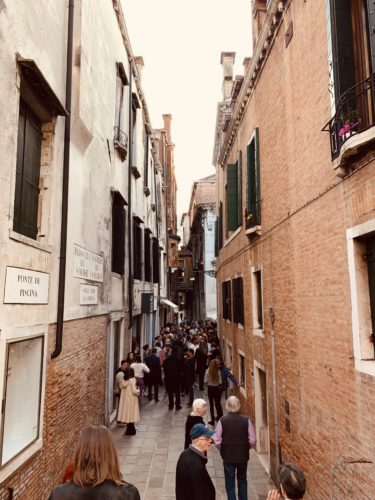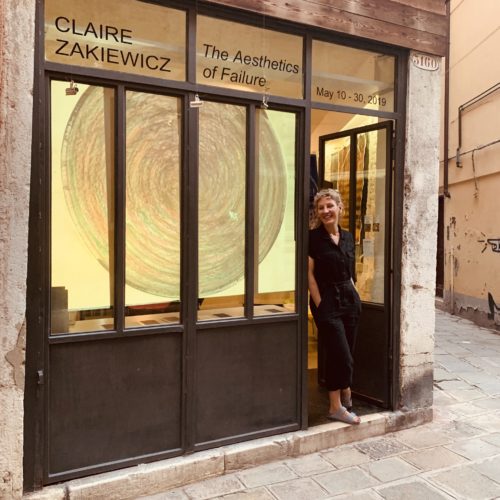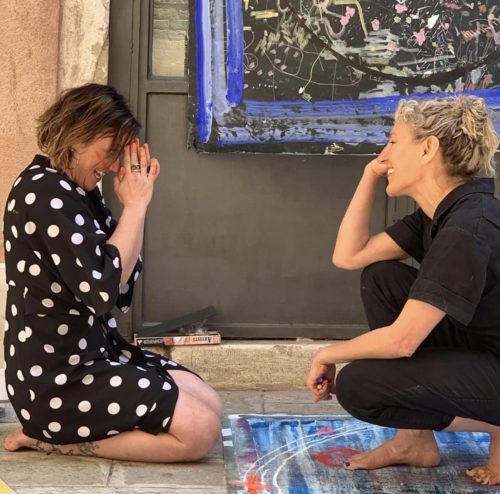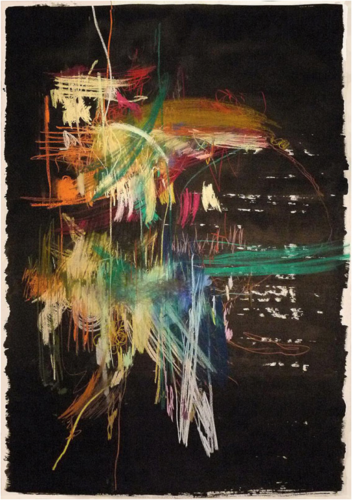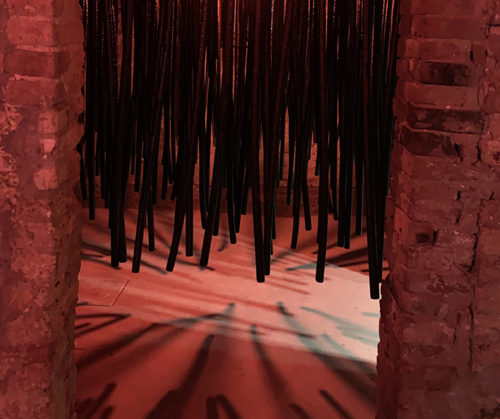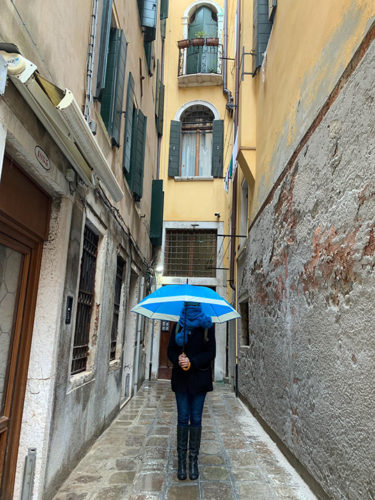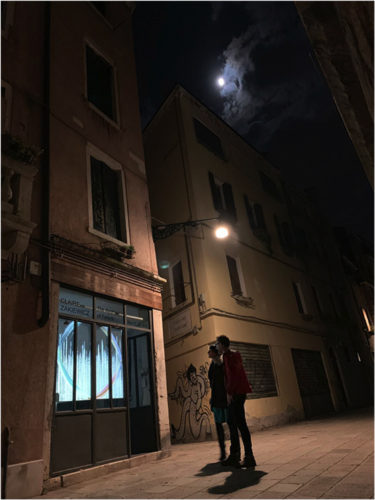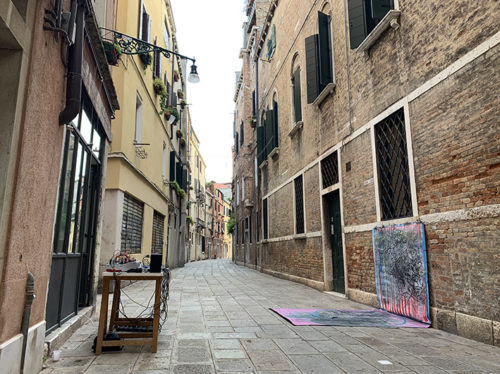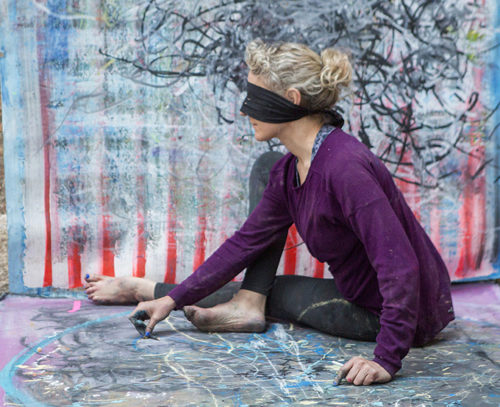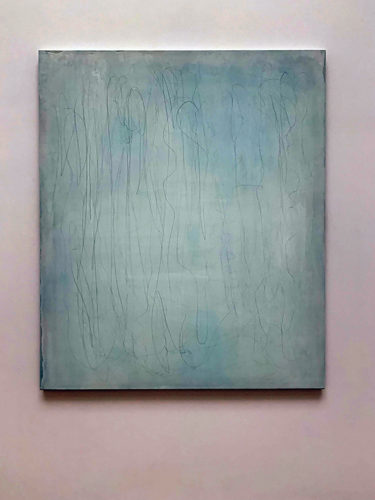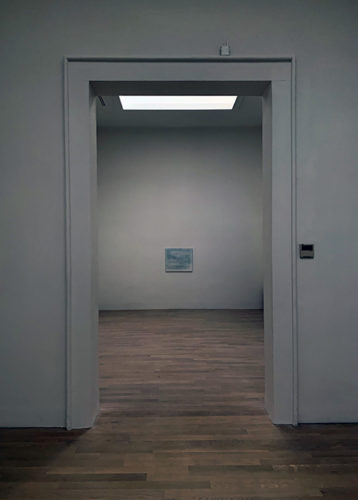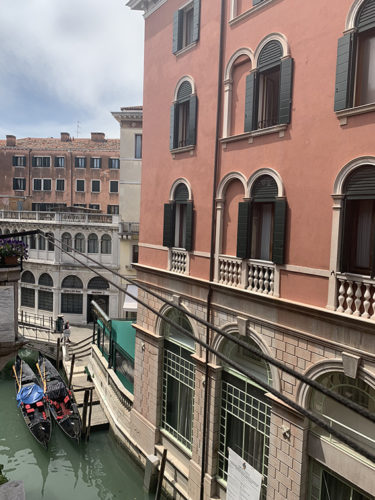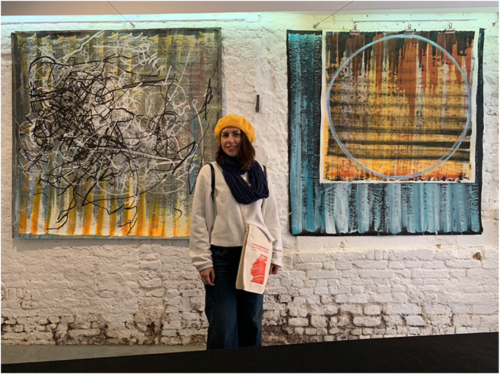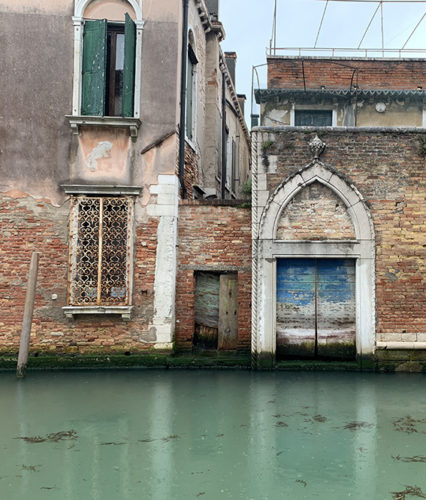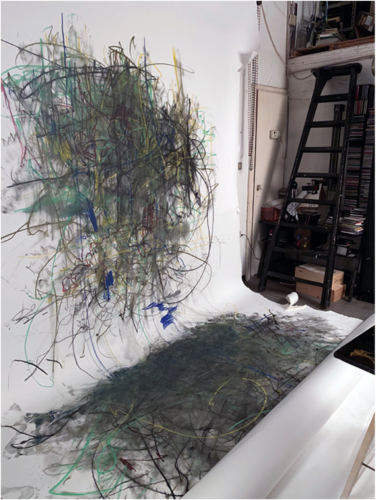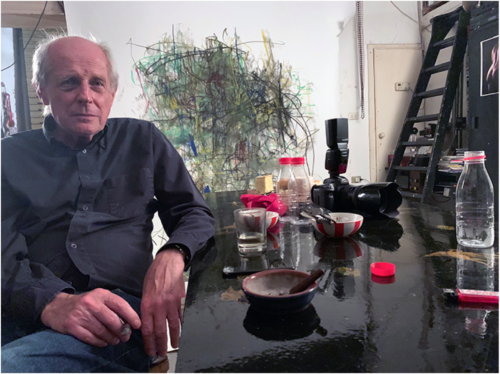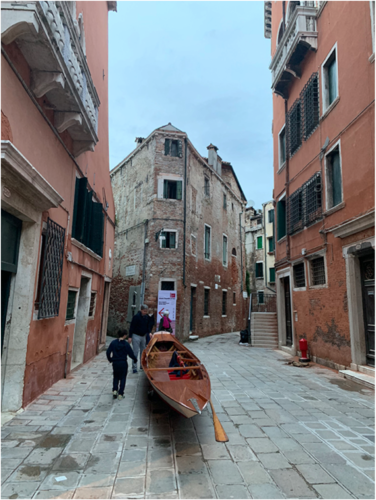The first time I went to Venice was for the contemporary art biennale in 2009. It felt like an overdose of culture and I wondered whether it would kill my love for art but after a short recovery an addition grew and I have been back to Venice more than twenty times since then. Let me be clear. There are many things I don’t like about Venice: it’s a playground for the mega-rich, most of the permanent ‘galleries’ are beyond kitsch – and not in a good way – yet somehow the Venice Biennale consistently manages to present an exemplar of works that give a tremendous sense of what is going on within the practices of some of the most interesting, poetic and profound artists around the world. Every two years it provides an historic account of what is capturing humanity’s imagination at a particular time. The Venice Contemporary Art Biennale is a unique art event that begun in 1895. Artists are represented within National Pavilions at the Giardini and Arsenale – huge sites that take at least 2 days each if you aim to see every artwork. There are also off-site exhibitions and projects, such as my own – by independent artists, curators and gallery owners.
Three years ago I asked a friend who lived in Venice whether he knew of any studios I could rent for the summer – so that I could live and make-work during the contemporary Art Biennale. He did better than that – he set me up with a few Venetian gallerists, one of whom was Anita Cerpelloni. My first exhibition in her space, titled Out of the Mothership happened in July, 2017 and I went back in September, 2018 with my performance ensemble Assembly for the exhibition: Perspectives In Motion.
This year, my project titled IMPRECISION: The Aesthetics of Failure draws upon work I have produced alongside an essay written for British philosopher Andy Hamilton’s forthcoming publication The Aesthetics of Imperfection. The show will run during the opening month of the 58th Venice Biennale. I will be writing a daily diary of the exhibits, experiences during my time here. I also have 6 video pieces screened daily at the exhibition Alive in The Universe curated by Caroline Wiseman at Palazzo Pesaro Papafava.
May 7
Today I started setting up my exhibition with the gallery owner Anita Cerpelloni. This year Anita will be giving workshops every Sunday in the gallery for the duration of the exhibition. The first will be a Japanese Calligraphy workshop.
I put up the window lettering and come back later in the night when it’s quiet and I can meditate on the works to be hung and the videos to be projected. Today is my only day and night alone. Tomorrow my friend – curator at ArtFare, Daniela Holban will be joining me for 7 nights. On Thursday my friend and collaborator Dannie-Lu Carr will arrive and we will perform together on Friday. Over the weekend and next week other friends and collaborators will arrive for further performances.
There are openings already happening. I passed through Victoria Miro’s opening of Njideka Akunyili Crosby “The Beautiful Ones” and noticed many others throughout the city that I wasn’t able to stop at.
While I have been working in New York over the past five years there has been an increasing lean towards female artists and artists of cultural minorities (in the usually Westernised contemporary art scene). Selecting Crosby as the artist showing during the opening of the Venice Biennale seems a contemporary statement, ticking multiple trend boxes. Fun fact: there will be 43 female and 38 male artists exhibiting their works at the Giardini and Arsenale for the main exhibit titled May You Live in Interesting Times curated by Ralph Ruggof. This statistic is important taking into consideration the completely male dominated world of Art since the beginning of Art History. I’m not sure this statistic has ever tipped in favor of women before. Is it a fad or is a lasting change? And I wonder which national pavilions will be following suit.
May 8
I woke up today feeling very nervous. I had a horrible dream about my teeth falling out! I also feel if I’m not careful I’ll come down with a cold. It’s raining.
I worked on administrative tasks then I had a video call with my curator friend Melissa, who advised me on promotional strategies and writing the invitation to be sent out tomorrow for the performances and opening event. After that I had to rush to meet Anita, the gallery owner to talk about the hanging of the space. Pumped with caffeine at this point it was a productive meeting from my perspective. We decided to run workshops every Sunday: Japanese calligraphy, bookbinding and experimental printmaking. I suggested performance workshops but Anita thought that would be difficult for people. I’m going to consider putting a performative spin on the workshops in any case. Perhaps addressing ideas of improvisation within the techniques.
It’s raining, the art world is pouring into Venice but looking a just a little fed up with the weather today, standing somewhat soggy under umbrellas and canopies. There are many openings tonight but I decide to go back to my apartment for one last quiet evening working on my stop-motion animation and preparing for Daniela, who is arriving from New York late tonight and I’ll be meeting her at the top of Rialto Bridge. Tomorrow morning my friend and collaborator Dannie-Lu Carr will be arriving from London to perform with me on Friday. It is also the Biennale preview over the next two days. There are two main Biennale sites – tomorrow I’ll be going to the Giardini, which houses the British and USA Pavilions, which have to be my first call, although that sounds so embarrassingly nationalistic. I expect nationalism to be a theme in many artists’ work this year with politics being what it is in Britain, America and elsewhere. I’m happy that my performance ensemble Assembly is very multi-national and sad that Venezuelan dancer Mariana Alvierez, who performed with me every single day for 3 weeks here last September can’t make it. At some point in the day tomorrow I’ll be rehearsing with Dannie-Lu for the performance on Friday lunchtime. I have so many ideas for this performance… in many ways I am beside myself with excitement. I’m not sure what is more exciting, seeing the works in the Biennale or doing my own project here.
May 9
With the pressure and excitement about my forthcoming exhibition and events it is no surprise that I have woken up with a cold. It’s much earlier than I usually get up and I could give myself a little more time in bed but I am excited. It’s the preview of the Venice Biennale today and I have just organized a ticket for my friend Daniela and am meeting the gallery owner Anita there at lunchtime.
At the Giardini I thought the main show in the central pavilion was fantastic. A light mist falls gently from the roof as we enter. A favorite work is by Ryoji Ikeda – a corridor of intensely bright fluorescent tubes – so bright that it is difficult to see. There are works by so many artists who are main influences for me – Julie Mheretu, Christian Marclay, George Condo and many others that are new to me that I’m happy to now know. I will review these works in more detail over the next few weeks. I managed to see less than half of the National Pavilions and the queue for the British Pavilion was too long for my patience so I will need to come back many more times to write up some detailed reviews.
After the Giardini closed I had to race over to Palazzo Pesaro Papafava on the other side of the island the opening of Alive in The Universe, which is screening 5 of my video works and some works by friends such as Hector Canonge and Scotto Mycklebust. The videos looked great, I stopped by my own gallery en route home and made some adjustments ready for my rehearsal with Dannie-Lu Carr first thing tomorrow morning.
May 10
I wake up and realize that I had turned off my alarm in my sleep. It’s 3 hours later than I had planned, I have a fever and I need to meet Anita at the gallery in one hour. Last night I talked with Dannie about hanging the show and I was convinced that it would be a very good idea to ask Anita to take down some of her beautiful ink drawings. They are confusing to have in the space when it’s advertised and presented as a solo show. I emailed Anita last night and I read her reply as I woke up – ‘sure, no problem. See you at 10’. I draw a tarot card – the Chariot. It’s time for action.
I carry a pack of tarot cards with me that was made by my friend, the artist and quantum physicist Dr. Libby Heaney. They are from her performance piece Phoxel Tarot and use symbols from the Internet. I usually carry them around with me a pick a card in the mornings.
Today has to be one of the most stressful days I can remember. After my morning coffee I crush my sunglasses in my hands for no apparent reason. I have to slash things off my to-do list and prioritize.
When I get to the gallery Anita is fantastic and helps me to arrange things so the gallery looks great. Dannie-Lu arrives at 11am to rehearse the performance but I haven’t finished re-hanging work so she helps me with that while we discuss. Daniela arrives in time to give some suggestions on the hang and then we go shopping for wine and pastels.
We start the performance roughly on time and we have a small but good audience. The head of Art from the university I attended is there and a handful of others. It’s a lunchtime performance and most of the art people are at the preview of the Biennale so I wasn’t expecting crowds. It was intimate and I managed to have a good conversation with the professor. I introduce Dannie-Lu and the performance. I wanted to highlight the importance of our collaboration in relation to my work. It is the relationship between the acting technique Meisner and my method of drawing. I also introduce the book OPEN we produced together.
After the performance we have time to spend a few hours at the part of the Biennale housed in the Arsenale. It was just a glance – we only managed to see a fraction of what is on display there but I saw that the artists I particularly liked at the central pavilion had work here as well. It was a very clever show and I’m looking forward to reviewing it in more detail. The evening continued to be packed with friends arriving from London, setting up my video piece in the gallery window, which runs all night and going to openings and after parties. The mega-rich are out, outfits are opulent and everywhere is a spectacle.
May 11
This morning I collect my laptop from the gallery, which has been playing my films in the window all night. I wear my running gear and lightly run through the morning crowds. En-route walking home I pick up groceries and plan brunch around a fresh plump burrata from the deli near the gallery that constantly plays rock and disco anthems. Supermarkets in Italy have the best produce than any other country I have been to and simple food is so much better prepared at home than any restaurant.
I have a restful few hours ahead to catch up with computer-based work. It’s the final hours before my official exhibition opening and I’d like to make sure I have everything printed and displayed and that I rest my voice before hosting this small party.
The forecasted made me decide not to do a live drawing during the opening reception but we tentatively set up drinks and snacks outside. I wear a dress, jewelry and heels and feel a different person from my usual paint-splattered self of late. It wasn’t a crowded opening but I hadn’t expected it to be. Starting at 6.30 on the day that the biennale opens and the golden lion is awarded was always going to be mostly friends. The art crowds are in the Giardini or Arsenale until 7pm, at the far side of the island. Whichever day or time would have clashed with other major events but perhaps in hindsight I might been better off doing the opening on Thursday when the pre-biennale buzz was at its height. However the opening of the exhibition Alive in the Universe was on Thursday, which is showing 6 of my films and on a personal level I didn’t want to miss that.
In any case my friends were with me, and many passers by stepped inside including artists from the Ivory Coast and Bharain pavilions. They left their details and I plan to meet with them over the next few days in their pavilions. A young arts management student asked me questions that were filmed and put online. Anita, the gallery owner cooked traditional Italian snacks, gave me a hand-made comments and contacts book and friends bought flowers. A group of us had a delicious meal afterwards at the restaurant on the corner. It was a special evening on many levels.
My cold is between feverish and streaming but if this were not the case I probably wouldn’t be sleeping. I could stay up all night and be on the move all day – there are so many things I want to be doing. Tomorrow Anita is giving a Japanese calligraphy workshop in the gallery. I would like to participate but friends visiting from London, New York and Brazil are going to the Arsenale and they leave town over the next day or two. I would also like to go back there and see more of the show. And my body is telling me to rest. Rain is forecast for the entire day tomorrow. We were lucky this evening it just rained while we ate indoors.
May 12
Today is raining for the entire day. Anita is giving a calligraphy workshop at the gallery but given that I have friends in Venice who leave soon I want to be with them and also see more of the Biennale. With Anita in the gallery I walk with Daniela to the Arsenale site under a large umbrella and very well wrapped up. It is colder here than in London and New York (I’m informed by numerous happy people reporting from England).
By the time we arrive at Arsenale my feet are wet, the weekend crowds are thick and my cold is streaming. Daniela’s time is short here so she heads inside but I still have three weeks to see the main sites so I go to some of the nearby collateral exhibitions, which are ticket-free. The first is Mongolia’s exhibition titled A Temporality. The artist is Los Angeles-based Mondolian artist Jantsankhorol Erdenebayar who has invited German guest artist Carsten Nicolai, aka Alva Noto (with the participation of Mondolian throat singers N.Ashit, Kh.Damdin, A.Undarmaa, D.Davaasuren). It is located in the allyway of Calle dell Forno, Castello – between the Arsenale and Giardini sites. I am immediately drawn in. I love the sound of Mongolian throat singing and sometimes use it in my own sonic works. It’s a vocalising technique, which the exhibition describes as being ‘used to communicate with inner selves, surroundings and nature’. The sonic work plays throughout the slightly damp, cavernous former bakery. Carsten Nicolai translates the ancient technique into a more contemporary art form although there is no explanation as to what makes the process and outcome contemporary rather than ancient and I am left wondering. Jantsankhorol works are huge textured black or cream sculptures with red light emitting from inside or behind them. They remind me of primitive life forms or otherwise futuristic – worms, slugs or possibly plants. They have a disturbing feel to them as they take over the space – hanging from the ceiling of one room rendering it impossible to enter. It is an immersive installation that activates feelings for me, rather than thoughts.
The rest of my day is spent catching up with the friends who are due to leave Venice very soon. This week I have a performance at my own exhibition space on Wednesday evening from 7 – 8:30pm with British musician Paul Morgan and there are things in the gallery that I still need to set up. Another set of friends will be arriving over the next couple of days. It would be very easy not to rest at all here in Venice at this time, but my cold is forcing me to head home and sleep early.
May 13
Usually the Biennale site is closed on a Monday but today is the only exception until it finishes in November. Daniela heads to the Giardini to see the Venezuela pavilion, which had been locked up – leaves and rubbish piled up outside – throughout the preview and opening days. Paolo Baratta, the president of the Venice Biennale, said during a press conference that the pavilion was now scheduled to open on May 13 (today) and that the late opening is due to the humanitarian and political crisis over there delaying the artists setting up. However the pavilion is still looking the exactly the same except today somebody stands outside with a sign that reads STOP LYING. There is no indication who the sign is directed towards but I wonder whether it might be collected to John Pilger’s recent article titled The War on Venezuela is Built on Lies (Feb 21, 2019) or the same line of thought. Curator Oscar Sotillo, the founder of left-wing cultural journal La Mancha, organizes this year’s Venezuela Pavilion. Titled ‘Metaphor of three windows.’ presenting artists Natalie Rocha Capiello, Ricardo Garcia, Gabriel Lopez and Nelson Rangelosky. Scouring the Internet for news, there are virtually no reports explaining the situation any further. I think back to my exhibition last year with the fabulous Venezuelian artist and dancer Mariana Alvierez and I text her to ask whether she wants to work with me in some capacity via video call. She replies and we set up a time to work out a plan. She tells me that the situation in Venezuela is like a movie at the moment ‘I don’t believe in anything’ she texts.
My friends, the musician Paul Morgan and Michelle Pound are arriving tomorrow for a performance with Paul on Wednesday at 7pm as part of the performance schedule for my exhibition. I cannot afford to be sick and I need to rest up. So I spend the majority of today under a blanket.
I am writing an essay alongside the drawings and performances of my exhibition that discusses the fundamental components of the act of improvisational drawing. It is for a collection of essays that is due to be published by Bloomsbury and edited by British philosopher and contemporary music critic Andy Hamilton titled The Aesthetics of Imperfection. A draft of the essay was published by the Brooklyn-based publication The Hypocrite Reader in January 2019 and I need to finish the final version within the next few days so that it can be sent to the publishers in time. These final edits include obtaining permissions to use chunks of text and images from friends and also making sure I have the page numbers of book references.
In the essay I discuss my process and research, which is focused on exploring relationships between sound and drawing. Some of these relationships are more physical, while others more conceptual. I consider the tension between failure and resolution, and the balance between control and surrender – and suggest how my experience as a painter and a performer draws and sheds light on the cognitive processes that underlie our emotional relationship with art.
May 14
Today I meet with musician Paul Morgan who has come over from London to perform with me tomorrow as part of the exhibition performance schedule. He has carried with him a spectacular modular synth that he soldered, assembled and re-wired himself. It’s a complicated looking machine with a colorful mess of patch-cables. He explains that although it took a great deal of time to assemble, the synth is built for an improvised performance with very little post-production, he will conjure a soundscape in conversation with my live-drawing performance, essentially using me as a proxy painter to draw the sounds. We discuss doing a series of performance throughout the summer back in London. The set up is ethereal in nature, he explains, each performance will be entirely different both electronically and from a sound perspective. The process makes use of happy accidents with mistakes making up the material – learning through failure.
The performance will take place on May 15 between 7:00 – 9:00pm and we will rehearse in the space during the day, when the gallery is open for viewing. Wines will be served and all are welcome! Address: ARTI3160, Salizzada Malipiero, 3209, Venice, Italy
May 15
Today is spent with musician Paul Morgan, who has come over from the UK with a spectacular modular synth, with which he is able to create an improvised soundscape to manipulate and accompany my drawing performance. During the day we discuss the parameters of the performance, which starts at 7:30pm sharp, as the bells ring. As agreed, we perform for one hour in order to enter a meditative zone. I wear a blindfold to help focus on the soundscape and movements and I work on paintings, which are on the pavement, and also hung along the wall opposite the gallery, where Paul is set up on a table with his equipment. It’s a durational performance, which means that we do not expect the audience to maintain their full attention for the entire time. Some people have arrived who have seen our publicity and others, passing by, stop to watch. More people than I expect watch for the entire hour and the shape of Morgan’s piece ebbs and flows with the drama of extended periods of tension followed by moments of resolution.
The rest of the evening is spent drinking and dancing at a friend’s apartment until 4am at which time I take the short walk, alone to my own apartment. When I step out into the Venetian night I find myself among a procession of men wearing capes and chanting. I duck into a side alley a little startled and consider the strangeness of the situation as I listening to their whispering chants and urgent footsteps. I take some photos and walk briskly in the wrong direction. Realizing I need to turn back as there is no other way home I listen to the processionbegin to fade into the distance and I hear them embarking onto boats. I wonder whether they might be shooting a film – or perhaps it’s a secret society performing a ritual or ceremony. Between the hours of 4-5am is perfectly quiet in Venice and the history and energy feels intense and mesmerizing. I wait for the boats to set off before continuing along my way. I take a video of the boats disappearing along the canal and continue to film the rest of my walk into the magnificence of an eerily deserted San Marco and when I reach home I realize the photographs didn’t capture any of the caped men but I can – just about – make out the lights of the boats in my shaky footage.
May 16
I begin my day reading the essay by the curator of this year’s biennale, Ralph Rugoff, which is in the extra-large exhibition catalogue. May You Live in Interesting Times is the title he has chosen. It’s a fake Chinese curse cited throughout recent history and sounds, he says, uncannily familiar today. ‘Fake news and alternative facts is corroding public discourse and the trust on which it depends. For an exhibition that, in part at least, considers how art functions in an era of lies, it struck me as an apt title.’ I ponder his words as I go about my day.
Today we finally have sunshine so I open the gallery for a couple of hours and then take the 20-minute walk to the Giardini. The Venezuela pavilion still hasn’t opened but has a new sign outside that reads: IN RESTORATION. I see brooms and the outside patio looks cleaner. I reflect on the person who was standing outside the pavilion a few days ago with a sign: STOP LYING and my mind goes back to Rugoff’s essay.
The British pavilion, which had a long queue last week, is quiet today so I walk straight in. The artist chosen by the British Council to officially represent Great Britain is Cathy Wilkes, an artist from Northern Ireland who lives in Glasgow. It is an exhibition that requires quiet contemplation, reflection and is subtly poetic – probably not to everybody’s taste. The sight lines have been very carefully composed, the space is as sparse as the delicate, muted and minimal paintings, which sit alongside found objects such as crystal nick-nacks, dried flowers and figures composed of plastic and concrete. It feels like a huge, immersive shrine. There are no lighting tracks – she has brought in as much Venetian light as possible from the open skylights and windows. The space changes in atmosphere as the sun moves or disappears. There is very little information about the show available and the works are all untitled. One of the interns was at my performance last night and she explains that some visitors have asked whether Banksy was representing Great Britain this year. His new graffiti works that appeared around the city during the opening last week have gained a lot of media attention.
I have bought a multiple entry ticket for the Biennale, which I can use until the end of the exhibition in November. This gives me the luxury of being able to do brief visits to the main sites but to come back frequently, giving me a chance to reflect. I sit on the grass in the sunshine and watch the art crowds. It is far quieter than the opening week, which I can barely believe was just one week ago. I expect the weekend will be busier, although it is forecast to rain all day on both Saturday and Sunday. There are films, some of which take up to an hour to watch, so the rain might hold audiences inside. I want to spend more time outside today so I walk back to the gallery to set up the video in the window, which plays all night.
Back home I read the other essay in the catalogue by the Biennale president Paolo Baratta. He writes, ‘our exhibition must be open and without any boundaries. The word ‘open’ resounded in us… open, in order to represent art as a phenomenon of humanity.’
Over the past year I produced a book titled Open, which is on display alongside my exhibition. It was produced in collaboration with poet, Dannie-Lu Carr, who performed with me last week for the preview of my exhibition. The book and performance were an exchange between the spoken word and the physical act of drawing. I sent words and drawings, connected to my research in the aesthetics of improvisation, to Dannie-Lu, a leading specialist in Meisner, and an acting technique, which focuses on the principles of ‘truthfulness.’ Dannie-Lu responded with personal recordings of raw, intimate and brutally honest spoken poetic verse. One of these poems titled Fake Realismresounds powerfully at the end of today.
May 17
It is much busier around the gallery today than it has been all week and many people are coming inside to look around. Today it would have been good to have an extra person here to welcome people.
I am in an introverted mood, however, and I feel like reading and writing. For the past two years I have been writing a 2000 word essay for a book soon to be published on the philosophy of improvisation. The works and catalogue from the Biennale have prompted new thoughts and I realize I can make some of the points in the essay a little more eloquently. Encouraged by the Biennale curator Ralph Rugoff, who writes, ‘while the verbal statements of artists should never be confused with the discoveries made through their work – which offer us a scaffolding around which we might build very different ideas and theories of our own… In catalogue essays such as this, one typically finds quotes from philosophers, political theorists, historians, art historians, and only very occasionally from an artist. I have chosen to reverse that order of priority by quoting a number of the participating artists, and so to underscore the importance of their thinking to the process of formulating this Biennale Arte.’
I was commissioned to write the essay by a professor of philosophy at Durham University – Andy Hamilton for a collection of essays by artists across disciplines. The deadline was mid-may (now) but I have been given another two weeks to work on it. I originally met Andy in 2013 at the Borealis Festival in Bergen, Norway – a festival for experimental music in Norway. During that time I was doing frequent performances there with my ensemble Fig. Andy Hamilton was there to write a review for The Wire magazine and we spent some time talking about the connections between our areas of research – spontaneity, risk taking and methods of improvisation. Andy gave me his essay – The Aesthetics of Imperfection, which I read and then took with me New York, where I have been mostly living since then. Years later, in 2017, I was tidying up my storage unit in New York and I came across the essay again. I thought how it was still very relevant in my work so I took it back to my studio. By a stroke of amazing serendipity Andy Hamilton contacted me less than one week later – completely out of the blue. He said that he was working on a book as a continuation of his essay and wondered whether I would like to contribute a chapter. Since then I have had numerous conversations with Andy about the nature of improvisation in drawing and I gave a talk about my work at the Newcastle Jazz Festival for an event he arranged with other contributors. The title of my exhibition this year – Imprecision: The Aesthetics of Failure is in homage to this collaboration with Andy and will probably be the title for the essay – although I still have two weeks to change my mind.
In case you are interested, a draft of the essay was published athttp://www.hypocritereader.com/94/control-variations-improvised-drawingin February 2019.
I don’t have many days alone here in Venice so I make the most of this quiet time by myself. I write until 3am but I struggle to sleep. The experience from Wednesday night is still haunting me and I am tempted to go out into the silent Venetian night.
I post my ghost story on a social media site and realize a few of my friends who live in Venice are still awake as they respond to the story. I look at the rain outside and the sky, which is becoming lighter I decide to stay home but I purchase an audiobook on the history of Venice and fall asleep while listening to the improbable story of 5thcentury refugees, who through exceptional ingenuity and necessity built a city on the unstable marshland, and the incredible rise of the Republic of Venice. I listen to how the body of Saint Mark was stolen from Egypt and rests close to where I lie. I look over across the ancient rooftops and imagine what these buildings have witnessed and the secrets they hold.
May 18
Today I go to the symposium on TIME at Alive in the Universe. The curators, Caroline Wiseman and David Baldry have chosen 28 themes, one for each day, which artists have responded to through film, performance and sculpture. Themes and artists include ‘Egg’, by Sarah Lucas and Julian Simmons, ‘War/Peace’, by Maggi Hambling and ‘Self/Other’, by Eileen Haring Woods. In the main entrance there are 3 monitors where 6 of my video works are being screened every day for the duration of the exhibition from 10am – 6pm, alongside other films by artists such as Hector Canonge, Scotto Mycklebust and Marcus Cummins.
Today’s symposium features a two-screen video work by Andrew Hewish titled Omphalos and a set of tripod-shaped sculptures holding, what looks like grey and white rocks that have a navel-shaped orifice at the top. I need to open my own gallery so I miss Caroline’s morning reading of ‘A Timeless Moment’ but I arrive for the 3pm symposium with Prof. of theoretical physics David Berman, Caroline Wiseman and Andrew Hewish. Berman gives a fascinating explanation of why we experience time as moving in one direction due to our slow speed in relation to the speed of light. His presentation is followed by a passionate talk by Wiseman on her theory of creativity in relation to the first and second laws of thermodynamics. The audience is engaged and there is a lively question and answer session followed by drinks and mingling.
Caroline is writing a fascinating book titled Creativity Life and Soul of the Universe.I read her draft when I first met her through at the High Line open studios in New York. It’s beautifully written, giving an insight into her life and thoughts on creativity, as she runs the artist residency and arts club, Alderburgh Beach Lookout, by the sea in Suffolk, England.
The rain has been persistent all day and there is no sign of it stopping any time soon. With the full moon yesterday and Venice’s tidal lagoon, the gallery floods before the end of the day and we wade to higher ground. Floods are common throughout the winter but are rare in May; it feels like a very British weekend.
After the symposium Caroline hosts a dinner and the discussion becomes increasingly lively. I discover that the audience had been packed full of brilliant artists, some of whom are exhibiting in the exhibition and across Venice during the Biennale. There are many professors from the arts and sciences and we talk until the early hours. Finally I wade back to my apartment bare-foot, with my jeans rolled up to my knees, through beautiful flooded Venice.
Alive in the Universecontinues until June 4 at Palazzo Pesaro Papafava, Calle de la Racheta, 3764, 30121 Venezia, Italia and is open to the public 10 am – 6 pm.
May 19
I wake up late today and run to the gallery as I was expecting it to be busy – it wasn’t. I’d forgotten that Sunday is quiet in Venice, with many restaurants and bars closed, especially in my neighborhood of San Stefano. A few people come inside and I manage to do a lot of work but it’s cold and damp to the point that my fingers become numb. In the evening I go for a run to warm up and then have dinner and embark on a new project with a fabulous photographer who lives close to the gallery. I met him last year when my friend Mariana pulled him into the gallery – as she did with every passer by. He has since, very kindly, photographed all our performances and events at Anita’s gallery. His name is Mark Edward Smith – British, although born in Morocco – he is full of stories about glamorous adventures and encounters with famous artists, dancers and film directors. He has lived a nomadic life finally settling in Venice more than a couple of decades ago. He has a strong accent that I can’t quite place, speaks numerous languages and loves hosting large, multinational dinner parties in his quirky home, one of which was a leaving party for me and my friends last time I was here. He lives in his photography studio, in a charming, ancient building that opens into a surprise private courtyard. The building is just opposite the Iranian pavilion and is similar in shape (but of course a tiny version of) New York’s Flatiron building or London’s Cheesegrater (turned on its side) and I pass it every time I take the public gondola across the Grand Canal.
While Mark was taking photographs of my performance with Paul Morgan last week he had an idea for a photography project whereby I work onto enormous rolls of black and/or white photographer’s paper – of which, I discover, he has many. I have been thinking about what I’m going to do with the paper and I come prepared with a travel speaker, a musical track plus boxes of pastels.
I like to produce drawings in response to musical recordings because they provide a set duration as well as a structured pattern than I can listen to and repeat over again to produce a series of drawings with a similar size, density and energetic quality. When drawing music the tension and movements affect the mark making directly so minimal yet dramatic is a good combination. One piece that exemplifies, for me, drama and minimalism is Steve Reich’s The Desert Music (1983). The title and texts sung by the choir come from William Carlos Williams’ book of collected poems by the same name that give an impression of some of the fundamental principles of music: repetition, pace, tension and resolution. In the third movement the lines of the poem ‘repeat and repeat again’ are layered and repeated, ‘as the pace mount’ they sing, ‘the theme is difficult – difficult – dii-fii-cult…’ the choir repeats and the tension keeps growing. The movement resolves at the end of the poem, the last word repeats re-solved, re-ee-solved, before continuing to the next movement.
In Mark’s studio I perform an automatic drawing in response to The Desert Music, which is approximately 48 minutes in duration. I work in continuous motion using the pastels. The size of the photography paper easily fits my entire body with arms stretched out in all directions, I am able to reach, stretch and stand on my hands and move around on the floor. My movements are spontaneous and impulsive and I use acting and movement techniques, in order to be primal and animal-like. The Meisner technique has been particularly useful in order to influence the character of my gestures while maintaining a level of conviction or truthfulness to how my body wants to respond to a situation in the present moment. Stanford Meisner told actors not to think and not to create but rather to respond impulsively within a set of crafted circumstances. Contact improvisation is another practice that helps me to move in continuous motion using the walls, floor, maybe other dancers, or any object I am in contact with – with my attention on gravity, balance and movement. The drawing is finished when the music stops. The aim, for me, is losing track of time and space – being in a timeless moment. The gestures involved in this technique have a similar quality of line to the traditional Japanese ‘enso,’ a circular ink drawing, symbolizing enlightenment and the universe. Improvisation in drawing is related to the aesthetics of imperfection, the unfinished and uncontrolled – the accidental and the incidental – themes that I have been exploring for my current exhibition. In my drawings, I think it is clear that improvised gestures have a greater sense of unity and flow than those made with conscious thought. I have also noticed how drawing while deliberately aiming for something ugly can produce beauty; drawing with one’s attention on something other than the drawing almost always produces a balanced quality of line and symmetry, even – or especially – on a large scale for a prolonged period as control slips further away.
In acting classes that I’ve taken it seems clear that allowing ways of being that we naturally prefer to hide – weakness, nervousness, wobbliness – can be the ingredients for the most compelling performances (and drawings). Psychoanalyst Thomas Moore has written about the need to ‘carry the fool’ as an essential ingredient in the creative process. With that in mind, the challenge of mixing chalk and oil pastel, having an uneven wall to draw onto and the paper not being properly fixed to the floor are all embraced. I sometimes even try to make ‘bad’ drawings as a means to make myself think or behave ‘outside the box’ or to create new patterns of behavior. Surprisingly often, ‘bad’ ideas and situations have turned out to be ‘good’ in one way or another. I feel that allowing imperfections to be not only visible but in focus allows us to consider the life, history, and value of the hand-made object. Although connected to deadlines and death, failure and resolution are both as fleeting as any other point in the flow of time. What comes next is making something new.
After producing this enormous drawing and taking thousands of photographs, which now need editing, Mark produces a decedent dinner of cheese, pasta, wine, ice-cream, whipped cream, followed by a cigar, which seemed appropriate. After a long discussion about life and full of plans for another session later in the week, I walk back to my apartment, which involves another wade through the high tide at San Marco. I also check on my film, which plays in the window of my gallery, which is along the way.
May 20
I’m staying in a comfortable apartment on a little square called San Gallo, steps away from the magnificent Piazza San Marco – one of the most beautiful squares in the world. Each window of the living room and kitchen looks over at a canal where gondolas pass. How did the universe open up this experience for me? Was it luck or is the opportunity equal to the hard work and sacrifices I have made? My close friends would argue hard that the latter is true but Venice is a place for contemplation – the contemporary art, churches and the medieval passageways and alleys, the reflections in the canals.
I wake up wanting to go back to the Biennale but the main sites are closed on Monday. I went to the Arsenale during the preview and was struck by the hard-hitting works that seemed to pack a punch – one after the other. I wanted to take some time to reflect on what I had seen before going back. The work that struck me hardest for was a fishing boat, which on April 18, 2015 more than 800 refugees died. The surprisingly small, brightly coloured yet distressed vessel was designed for a crew of 15 people. It was installed as an art exhibit by Swiss-Icelandic artist Christoph Bücheland titled Barca Nostra (Our Boat). I look for a label. My friend Daniela had already told me about the ship and the surrounding controversy of the exhibit and I wanted more information. However, it is deliberately unlabeled. I’m sure the vast majority of visitors to the Arsenale won’t read about the works beforehand and I have already seen photographs on social media of grinning celebrities in front of the boat – surely oblivious of its grim history, which seems somewhat unfair. Knowing the story in advance, the boat seems incredibly haunted to me. The horror that took place is impossible to imagine yet impossible not to.
The lack of information and the grinning tourists in front of the boat might seem unfair at first but as I work in my comfortable warm apartment spending hours writing about improvisation in my drawing process – an attempt to understand a universal, fundamental creative process. I feel there is a political element to my work but in many ways it is an escape inwards because I have given up trusting the main political news channels.
Later friends arrive and we go for evening drinks, walking past luxury yachts the size of battleships. They talk about Brexit and a friend’s teenage daughter talks of her history classes and events that took place during the second world war. I’m not sure why I had never heard about the vessel on which 800 refugees died. It would have happened just before Trump was elected and around the time that Britain voted to leave the European Union. Events that have hijacked new stories ever since. At this point I am not even sure where it happened and where the refugees were from and where they were going. I wonder how many people actually know. How many people will try to find out after visiting the exhibit? Later I google it and discover it sank in the Sicilian Channel but I had to read 5 or 6 articles to discover the boat came from Libya. For me the exhibit works as an intervention – through our lack of care to find out more information than what we are spoon-fed we can easily end up on social media grinning in front of a haunted vessel. If we knew more about it, if we understood the reality of what happened, we might start discussing the migration crisis that is happening right now and not far from the comfort of our holiday homes – but for now nobody, it seems to me, is talking about it.
